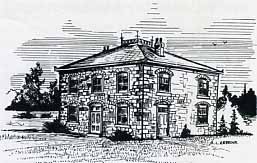
Click Here to Return To Milestones Vol 7 N0 1
Click Here to Return to Schools Index

This institution, the oldest of its kind in the county, owes its origin to Reverend Thomas Hughes. Upon his arrival in 1802, Reverend Hughes built a log cabin, on his lot, and began in it the work of his heart. At a meeting of the Presbytery of Erie, held at the Mount Pleasant Church, April 13,1802, he brought up the project of establishing an academy and laid his plans before it. From the minutes the following is copied:
"Presbytery proceeded to take into consideration the necessity of a seminary of learning being instituted within their bounds, for the education of youth. RESOLVED, to give their aid to erect an academy at Greersburg, and to solicit the aid of thier respective charges."
Proceedings were immediately made for its erection, as the date of 1802 cut in a stone in the wall will show. The legislature of Pennsylvania passed an act February 24, 1806, establishing the new school at Greersburg Academy; but the building was not occupied until after this date.
The sum needed for the erection of the building was very slowly raised. It is said Reverend Hughes traveled several hundred miles on horseback to raise funds for the academy. One trip took the Reverend as far as Boston.
The first board of trustees was not chosen until 1806. It consisted of Rev. John McPherrin, Rev. George Scott, Rev. Thomas Hughes, Rev. William Wick, Rev. James Sheterfield, Rev. Nicholas Pittenger, Caldwell Semple, Alexander Wright, David Potter, Dr. Samuel Adams, John Beer, George Dilworth, William Scott, Joseph Pollock and Hugh Hagarty.
A curious regulation was passed during Reverend Hughes' charge relating to diet. It was RESOLVED, that breakfast shall consist of coffee and bread, with butter; that dinner shall consist of bread and meat, or potatoes; and supper, of bread and milk.
In 1883, after more than eighty years of service, the Academy was sold to to the Pittsburgh, Marion and Chicago Railroad Company. The building was renovated to become a railroad station.
The Academy, sentimentality regarded as the "Old Stonepile," drew a number of students who were to carve distinct niches in American history.
One of these students was John Brown, a fiery abolitionist, who led the raid on Harper's Ferry before the Civil War. Another, John W. Geary, was elected Governor of Pennsylvania in 1866 and was re-elected in 1869.
But the one graduate to make the most enduring impact on millions of Americans was Dr. William Holmes McGuffey, whose classroom textbooks taught generations of Americans to read. It has been estimated that more than 122 million McGuffey Eclectic Readers, Spellers, and Primers were sold from 1836-1920. His books on reading constituted the great library of literature for the children of the "little red school house" period. The books served as texts in morals, adventure, literature and a wide set of purposeful lessons on human conduct.
McGuffey was born in Finley Township, Washington County, Pennsylvania, on September 23, 1800. He spent his early years in Trumbull County,
Ohio, where his father Alexander, had staked a land claim and constructed a log cabin in which the family lived. There were six McGuffey children. Anne, Catherine, Betsy, Asenath, William, and Alexander Hamilton, who was later to assist his older brother prepare the texts that achieved worldwide renown.
William was taught to read and write by his mother. With no schools in the vicinity, he had little opportunity for education. Here legend mingles with fact as to how McGuffey came to Greersburg. Historians relate McGuffey's mother had prayed that some way might be opened for her son to obtain an education. In a sense her prayers were answered when Rev. Hughes was riding through the country and stopped at the McGuffey cabin. Reverend Hughes taken with the sincerity of the mother's wishes and the intelligence of the boy, "opened" wide the doors of the academy.
While attending the academy, William continued to work on his father's farm during the summer months and at harvest time.
It wasn't long before William was teaching the younger students at the academy and earned his tuition of $3.00 per quarter and the seventy-five cents a week for board.
In 1820 he graduated from the academy, and six years later graduated from Washington College, Pennsylvania. After his move to Ohio, he was appointed Professor of Ancient Languages at Miami University, in Oxford, near Cincinnati, in 1829. Dr. McGuffey resigned his professorship at Miami University in 1836, and relocated in Cincinnati to assume the presidency of Cincinnati College. In 1839, he was elected President of Ohio University, and in 1845 was chosen to the Chair of Moral Philosophy in the University of Virginia. Dr. McGuffey held this position until his death, May 4, 1873. He is interred in the University of Virginia Cemetary.
McGuffey's fame did not end with his passing. His textbooks continued to sell giving the young people of America the morals he was taught as a student at Greersburg Academy.
The Greersburg Academy is located in the town square of Third and Market Streets and is a well known Darlington landmark.